
Circular Economy Living with Christina Tan
Sustainable living may sound daunting and feel impossible, but it is something everyone can achieve through small daily actions. In this blog, we interviewed Christina Tan, a remarkable leader whose influence extends across various domains. Not only is Christina a distinguished figure in the energy sector, but she is also a devoted mother and a passionate advocate for sustainability, particularly in promoting the circular economy.
In this interview, Christina provides insights on creating memorable experiences with loved ones without a substantial budget, embracing sustainable businesses and resources, and nurturing environmentally aware children.
PT: Could you share a little about yourself and what aspects of your lifestyle align so well with the PlanToys community?
CT: I was born and raised in Los Angeles, and was fortunate to be in close proximity to the mountains, desert, and beach. These surroundings influenced my values and lifestyle and set the stage for my interest in my Master’s in Economics. During my studies, the book Green to Gold: How Smart Companies Use Environmental Strategy to Innovate, Create Value, and Build Competitive Advantage, drew me into believing that companies can and should care about sustainable business practices and our environment. Since then, I have strove to be a conscious consumer, and I look to purchase from companies that make notable efforts in reducing their environmental impact. So when I was shopping for a three-year-old’s birthday several years ago, I found PlanToys, and I’ve been a fan ever since! It’s this belief in high-quality products, mindful manufacturing, and eco-consciousness that make PlanToys my favorite toy company.
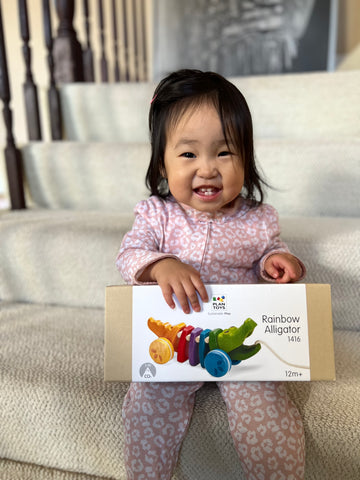
All photos are provided and owned by Christina Tan
Play is an effective way to instill healthy habits that they will carry into adulthood. The way you integrate the two into your family’s routines is inspiring. Could you share some play prompts, routines, or traditions that are intended to nurture eco-consciousness in your children? What inspires you to create them?
There are so many synergistic opportunities around us - almost any day-to-day task can be turned into a game, a lesson, or a teaching opportunity for little ones. Some of my favorite prompts are telling my daughter I need her help with a task or that there is “something cool” I want to show her. I recently made bagels and asked her to help me brush the tops with egg whites. Using just the egg white and saving the yolk to scramble later gave me a chance to explain one eco-friendly lesson - “try not to waste food!”
During the summer, my husband and I ask my daughter to watch us pick pomegranates from our tree, then count them. She watches us remove the seeds and squeeze them into pomegranate juice. As the pomegranate tree leaves fell throughout the fall, she helps us clean them. Now that spring is here, we’re looking at new leaves coming in.
When we’re outside, I’ll also point out bugs and animals with a lot of excitement, because I want her to find wonder and amazement within her environment and to eventually turn that into kindness toward the natural world. I hope that by regularly exposing her to the outdoors, it reinforces how fascinating the natural world is, and instills within her an appreciation for our environment.

How has embracing a more sustainable lifestyle unexpectedly impacted your life and your families? Could you elaborate on why you believe it’s beneficial for people to integrate sustainability into their routines?
The most unexpected impact is how much more aware I am of my health and the food I feed my body. In 2017, my sister-in-law passed away from cancer at the young age of 32. This led my husband to discovering that he carried the breast cancer gene, and opened our eyes to the proliferation of toxic-carcinogens in everything around us, from textiles to toys. The connection between sustainability and its impact on our health is a closed-loop with real impacts. Think about it - clean water, healthy food, and clean air are basic necessities we need to live, and they are all threatened by our unsustainable practices.
The good news is that choosing sustainable options are usually also the better choices for our health, and vice versa. For instance, as a health conscious family, we’ve shifted our body care products and food choices towards clean, organic items. This means we are choosing items that contain little-to-no chemicals, which then means reducing the demand for toxic ingredients and supporting sustainable alternatives. The chemical industry is the second-largest producer in the world, and it is nearly impossible to avoid chemicals in modern society. But for the sake of our health and the next generations, we need to take actions toward reducing our exposure to toxic chemicals. As consumers we can choose toys made of natural materials, such as wood and plant-based inks, to limit exposing our children to the long list of toxins found in plastics. While picking organic shampoo and wooden toys are small choices in our lives, the collective impact we can all have is massive, and in the end it will lead to healthier and happier homes and communities for all of us.
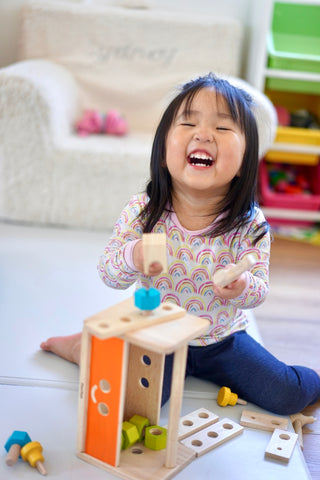
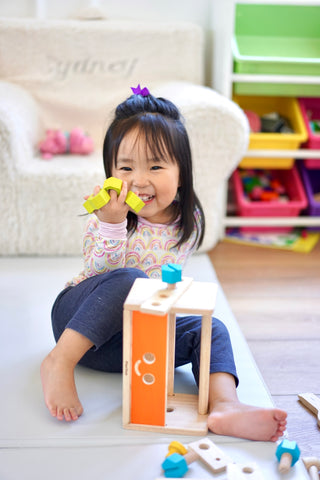
Mindful shopping is a practice we wholeheartedly endorse. Could you share some tips for how you embrace a circular economy within your community while also supporting the companies you are passionate about?
Before buying something new, I’m often asking myself, “Do I need this or do I want it? Can I find it on Facebook or OfferUp?” When throwing my daughter her first birthday party, I turned to my local Buy Nothing Group on Facebook to repurpose party decor. My friends and family were shocked at how many of the items were upcycled and were inspired to reduce their one-time-use party decor buying habits.
I think a large part of mindful shopping means being a minimalist and a reducetarian. When the 2015 documentary, The True Cost, came out exposing the dark side of the fashion industry, I was shocked and disheartened at how detrimental the fashion industry was to our environment. I made a personal commitment to shop for secondhand clothing as much as possible, and I’m proud to have stuck to that commitment for almost 9 years now. However, I'm even more proud of the fact that almost all of my daughters' clothes are second hand from our community!
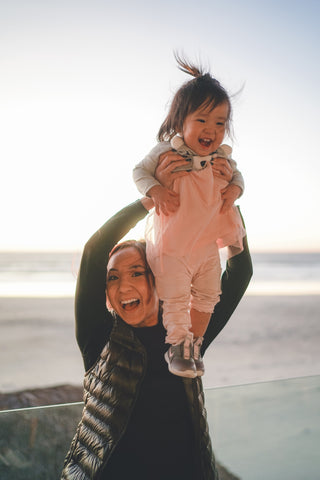
Do you have any favorite places that you would recommend for someone starting their own journey in the circular economy?
The very device you are using to read this right now is your key! There are many options, though my personal favorites are Facebook Marketplace, OfferUp, Poshmark, and ThredUp. To reduce my order’s carbon footprint, I try to bundle my items from the same seller on Poshmark. I also make every effort to sell back to these communities, post items for free on my Facebook Buy Nothing Group or give items to someone who I know would want to reuse them. I try not to donate to organizations that are known for having their items end up in our landfills.
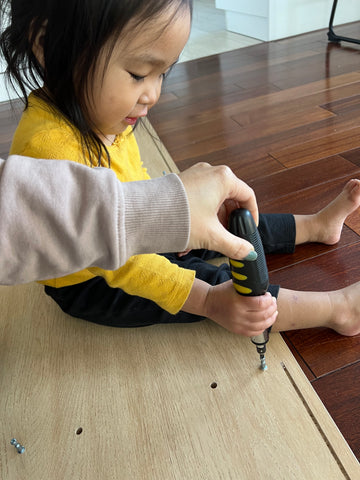
Check online communities for used furniture, and include your kids when building or repairing the furniture.
Could you share some advice for people who want to live more sustainably but might feel overwhelmed and are unsure where to begin?
We would find ourselves in a black hole and stuck with decision paralysis if we all tried to be 100% sustainable. First, keep in mind that just like any other lifestyle change, sustainability is a journey. Start small. Start by reducing your consumption. Set small goals in the beginning. Talk to your household about ways you can all reduce waste and be more eco-friendly.
I also recommend exploring the plethora of sustainability resources that are now available. The more informed you are, the better your decisions and choices will be. Some of my go-tos:
- I added Seafood Watch tto my phone home screen and check the seafood items for sustainability impacts when I’m grocery shopping.
- I love listening to the Sustainable Minimalists and Good Together podcasts. Both offer fantastic interviews, insights, and tips on eco-consciousness and sustainability.
- Green Matters (@greenmatters), 4ocean (@4ocean), and Recycle and Play (@recycleandplay) have amazing Instagram content. Speaking of social media, I recommend doing a cleanse by unfollowing brands that promote consumerism. Out of sight, out of mind, right?

In what ways can we inspire children to make sustainable decisions without being prompted by adults?
That’s a beautiful end goal. Just like how we hope to raise children who have integrity and make the right choices without adults around, wouldn’t it be wonderful if children were also taking actions for the sake of the greater good? I think it’s entirely possible, because children soak up more than we know. That’s why it’s important to include children in our day-to-day tasks, so we can explain why we do or don’t do something. “I’m buying these Easter eggs because they’re made of paper, the other ones are made of plastic.” We can show them the how and what and instill sustainable lifestyle practices in them from an early age, making it second nature and effortless for them.
Children are making so many connections and discoveries everyday, especially when something is fun to them. When my husband and I open junk mail or have paper to toss, we let our daughter color on it before tossing it out. Now when we get the mail, she’s excited and already asking which ones she can draw on. There are also plenty of arts and crafts that can be done from eco-friendly materials, like a used cardboard box, twigs and leaves, and old clothing. I’ve also pointed out all of the secondhand toys and clothes that my daughter has, to emphasize the circular economy that she’s part of when she is wearing her cousin Kennedy’s dress and playing with cousin Penny’s dolls. My hope is that highlighting how special these connections are will instill a future desire to contribute to the circular economy.

What are the must-have toys in your family’s play routines and what makes them so special?
As mentioned in another PlanToys blog post, we also implement a toy rotation and highly recommend it! There are a couple things that we never rotate out: her pretend kitchen and food items, building blocks, and dolls and figurines. To date, our daughter must have cooked at least a thousand “meals” with the PlanToys Cooking Playset we gifted her for Valentine’s Day last year. When she tries new (real) foods, she’ll incorporate it into her play cooking. She’s always expanding her menu, so playing kitchen never gets boring.
In her play area, we also keep a standard set of building blocks and a magnetic set. They allow her to take her imagination anywhere she pleases; in fact, sometimes the blocks get used as food items!
Lastly, she uses her dolls and figurines to add dimension to her storytelling and play. Here’s the mom, in her living room, and here is the aunty and uncle, cooking in the kitchen. It’s adorable and sometimes so funny to hear the conversations her dolls have, especially when she has assigned real life family members and friends to the dolls.
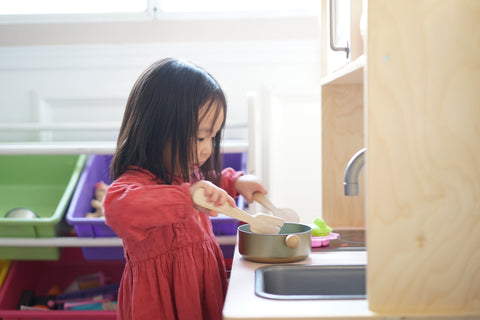
Stay connected with Christina at @perspectivesxchristina for further insights into her sustainable lifestyle and how she incorporates it into her family dynamic.
